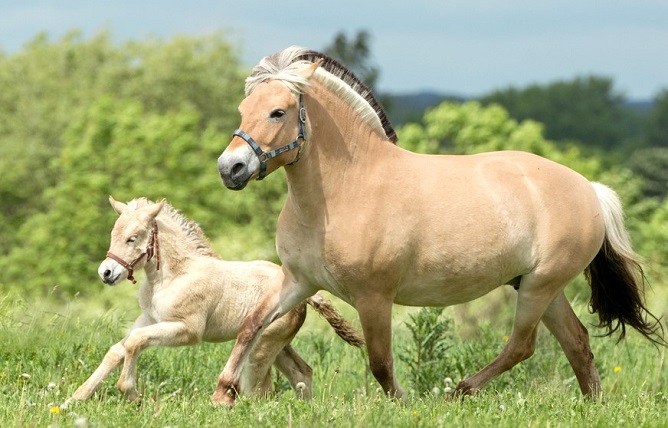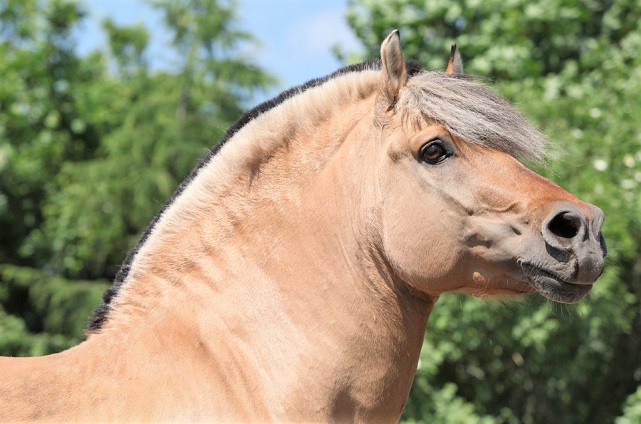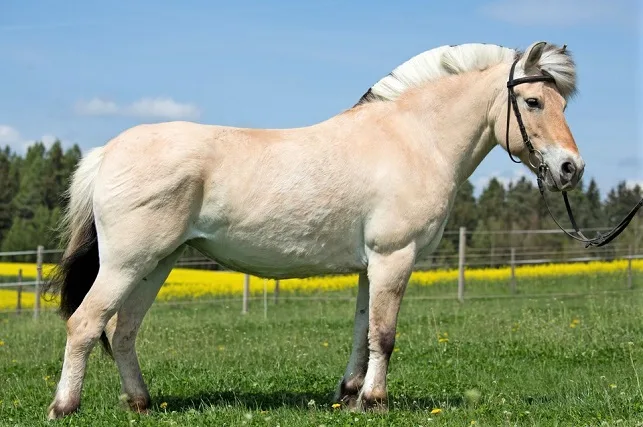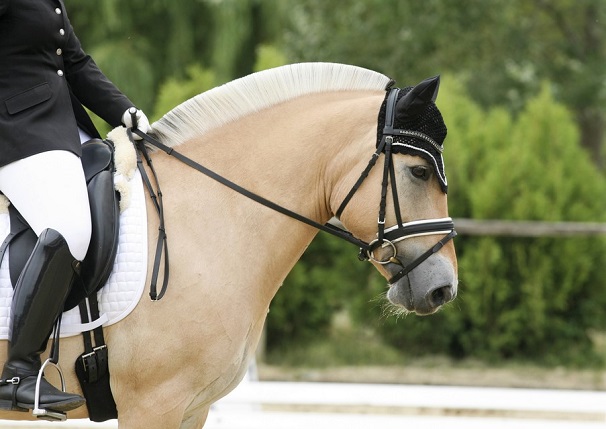The Fjord Horse is a very unique and easy-to-recognize horse breed that’s native to western Norway. Also known as the Norwegian Fjords, they are small but strong horses with good agility and a calm disposition.
Fjord Horses have a distinct outline featuring a strong and thick neck and often a dished face. They are always dun in color and have primitive markings, including a dorsal stripe and zebra markings on the legs. On some horses, horizontal zebra striping even appears on the withers.
While the breed doesn’t have specific height requirements, most Fjord Horses stand between 13.1 and 14.2 hands at the withers. They are equally suitable for riding and driving, and many people consider them great all-rounders.
Here are ten interesting facts about Fjord Horses:
1. The Fjord Horse is an ancient and pure breed
Fjord Horses are among the most ancient horse breeds in the world. The common belief is that their ancestors migrated from Asia to Norway, where the locals domesticated them circa 4,000 years ago.
The Fjord Horse is also one of the purest breeds on the planet, with minimal influence from other breeds. It is thought that Fjords are related to the primitive Przewalski horse, with which they share many characteristics.
Excavations at Viking burial sites revealed that Fjord Horses had been selectively bred for the last 2,000 years.
Before mechanization, Norwegian Fjord horses were mainly used as farm horses. The breed was also extensively used in the Second World War and were handy on mountainous terrain.

Maria Junge Fotografie / Shutterstocking
The breed’s hardiness, strength, and maneuverability made these horses indispensable to local communities.
2. Fjord Horses were once crossbred with Doles
In the 19th century, several breeders experimented with crossing Fjors Horses with Norwegian Doles to improve the breed. Also know for being strong and agile, Dole horses are slightly taller than Fjords.
Read our guide on how much a horse can pull to learn more about the strength of horse.
After a few generations, it became apparent that the Dole was harming the breed. Specific undesirable characteristics began to show, such as unattractive coloring and fierce temperament.
According to Karina Brez, by 1907, breeders decided to eliminate all traces of Dole blood from the Fjord Horse breed.
Once the decision was made, a stallion called Njal was chosen to restore the breed. During his 12 years of life, Njal became the founding father of the modern Fjord Horse. All members of the breed today trace their ancestry back to this prominent and influential stallion.
3. The war mounts of Vikings
The history of Fjord Horses is closely interlinked with the Vikings of Norway. The Vikings valued these brave and sturdy horses and often rode them to battle. They also played an essential role in the selective breeding and improvement of these horses.
It’s no surprise that Fjord Horses are a national pride in Norway. Two municipalities in Nordfjord, southwestern Norway, even feature the Fjord Horse on their coat of arms!
4. Norwegian Fjords horses have five recognized shades of dun
As of 1922, the Fjord Horse breed society recognizes five different shades of dun in the breed. These are the brown dun, red dun, grey dun, white dun, and yellow dun. Light cream horses with blue eyes also exist and are referred to as “white” (Norwegian kvit), but this color is undesirable in the breed.

Zuzule / Shutterstock.com
Brown dun is the shade you’ll come across most often in the Fjord Horse. Approximately 90% of all Fjord Horses are brown dun, and the other four shades make up the remaining 10%. The breed society aims to preserve all existing shades.
While they are often hard to distinguish, the five shades differ in their genetics. All Fjord Horses carry the “dun factor,” a gene responsible for turning a base coat color into dun.
A brown dun is created when a Fjord Horse has a bay base color. On the other hand, the base color is chestnut for red duns, black for grey duns, and cream for white duns, resulting in distinct shades of dun.
The yellow dun is the rarest recognized shade in the Fjord Horse breed. Their genetic profile is similar to red duns, but an additional dilution factor creates this lighter shade. Yellow duns often have white manes and tails, and their primitive markings are usually faint.
5. White markings are undesirable in the breed
White markings are typical in most horse breeds, but not the Fjord. The official breed standard considers any horse with white markings other than a small star unacceptable for breeding.
Fjord Horse breeders have been against white markings for centuries to create a consistent breed appearance. A small white star is only acceptable as one of the foundation stallions also had one.
6. Fjord Horses are powerful for their size
Despite their small size, Fjords are considered horses, not ponies. Their unique conformation combines the muscling and bone of a draft horse with a compact build and greater agility.
Fjord Horses are surprisingly strong for their size and will carry an adult human with ease. They are also known for being sure-footed and reliable over rough terrain.

Vera Zinkova / Shutterstock.com 7. Fjord Horses have a uniform hairstyle
You’re probably familiar with the classic roached manes of Fjord Horses. This horse breed has a naturally long and thick mane that can become high maintenance if left untrimmed.
To make grooming easier and emphasize the arch of the neck, Fjord Horse owners traditionally trim their horse’s manes to a length of 2 to 4 inches (5-10 cm).
This styling causes the mane to stand straight up, giving the horses a truly “Viking” look. Because the outer edges of the mane are much lighter in color than the dark middle, some owners cut these hairs shorter to emphasize the contrast between the two shades.
8. Fjords are popular therapy horses
Various characteristics make the Fjord Horse ideal for equine-assisted therapy. Their excellent manners and consistently calm demeanor make them safe to be around for vulnerable individuals.
What’s more, Fjord Horses have a natural swinging back and are comfortable to ride, which is another reason why they are a popular choice for riding schools and horse therapy centers. Their kind and gentle nature also make Fjords a suitable horse for children.

acceptphoto / Shutterstock.com
In Norway, Fjord Horses often transport tourists in carriages or compete in combined driving. There’s nothing these talented little horses won’t do, whether it’s English or Western riding, driving, or Natural Horsemanship.
9. Most Fjord Horses live long lives
In this aspect, Fjords are similar to the Haflinger breed. They have high average lifespans and will often work well into their thirties.
Karina Brez mentions a Fjord Horse called Gjest who’s still active in his local breeding program, despite being well over thirty years old.
With good care and a healthy lifestyle, Fjord Horses have the potential to stay with us for a very long time.
Also Read: 7 Interesting Facts About Haflinger Horses
10. A “fine” Fjord horse must score at least 70/100
Breed society shows score Fjord Horses between 0-100 regarding their conformation and performance.
Fjord horses with a score of at least 70 are considered acceptable. Horses rated 80 or above are exemplary.
Source: horseyhooves.com








